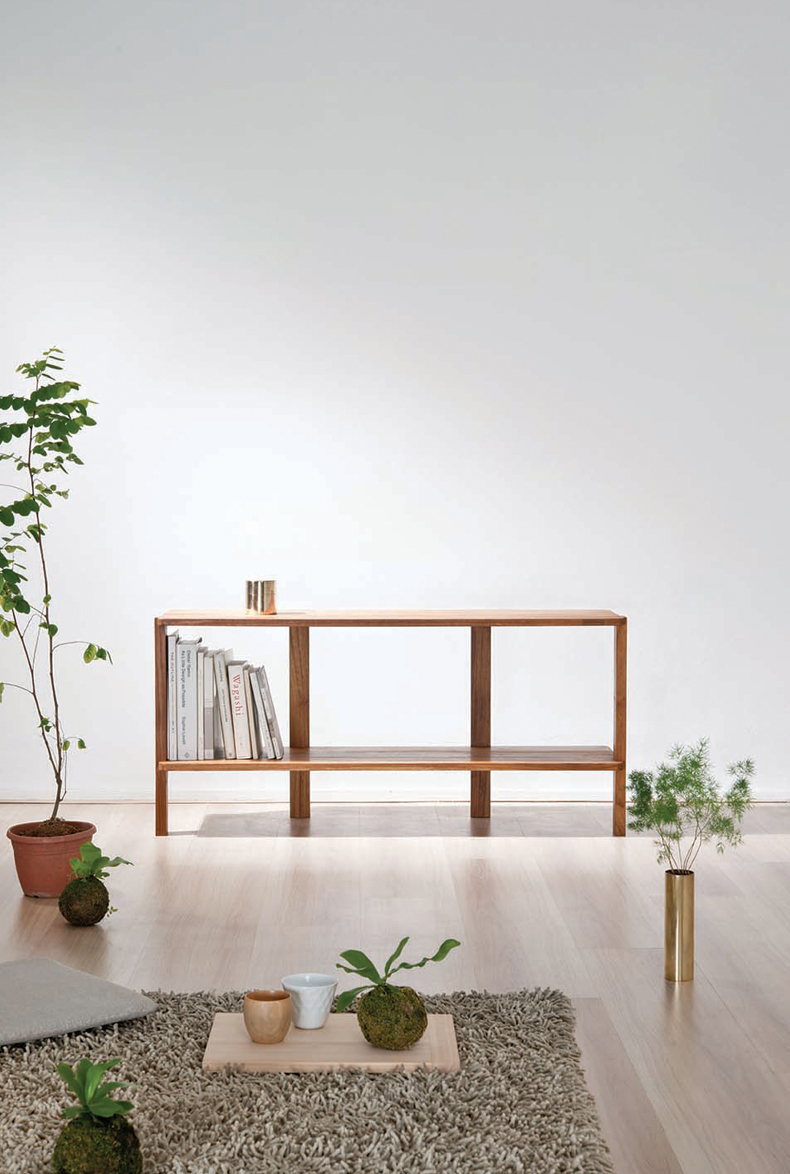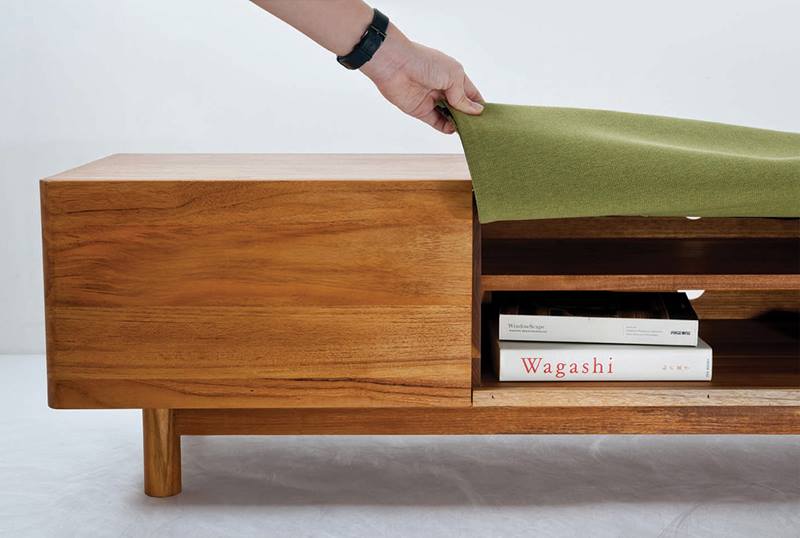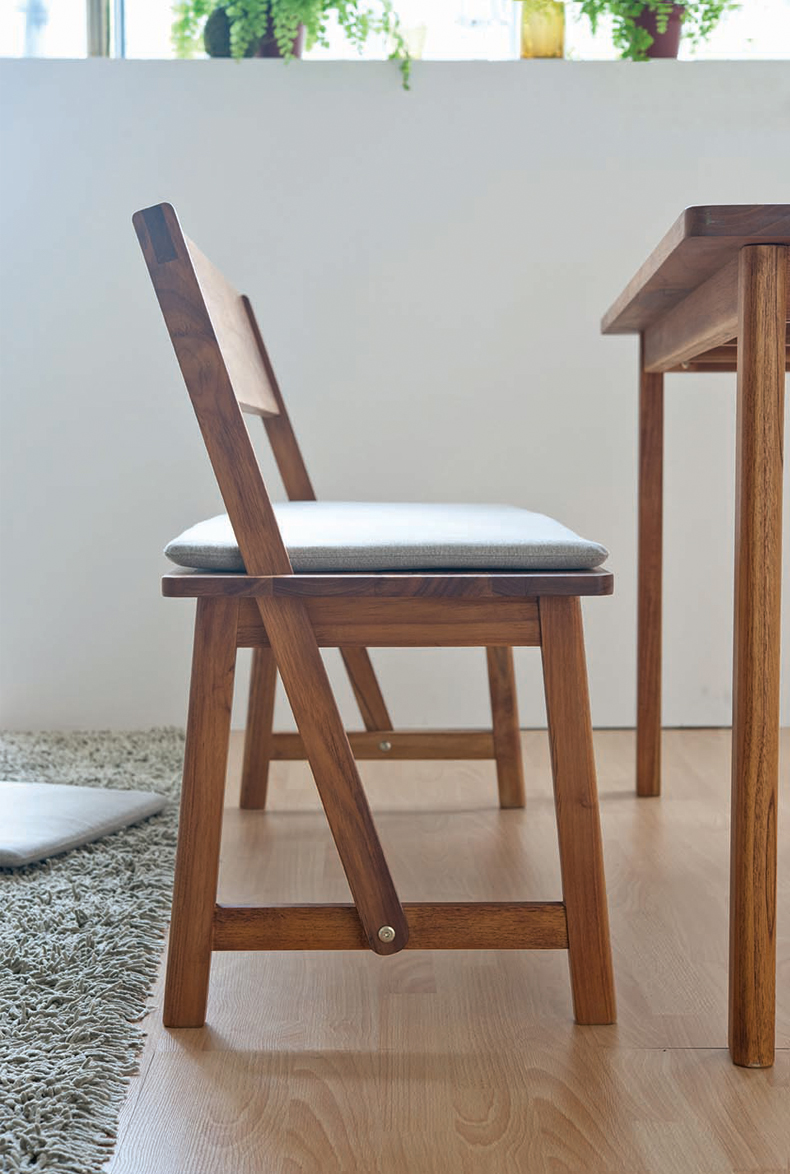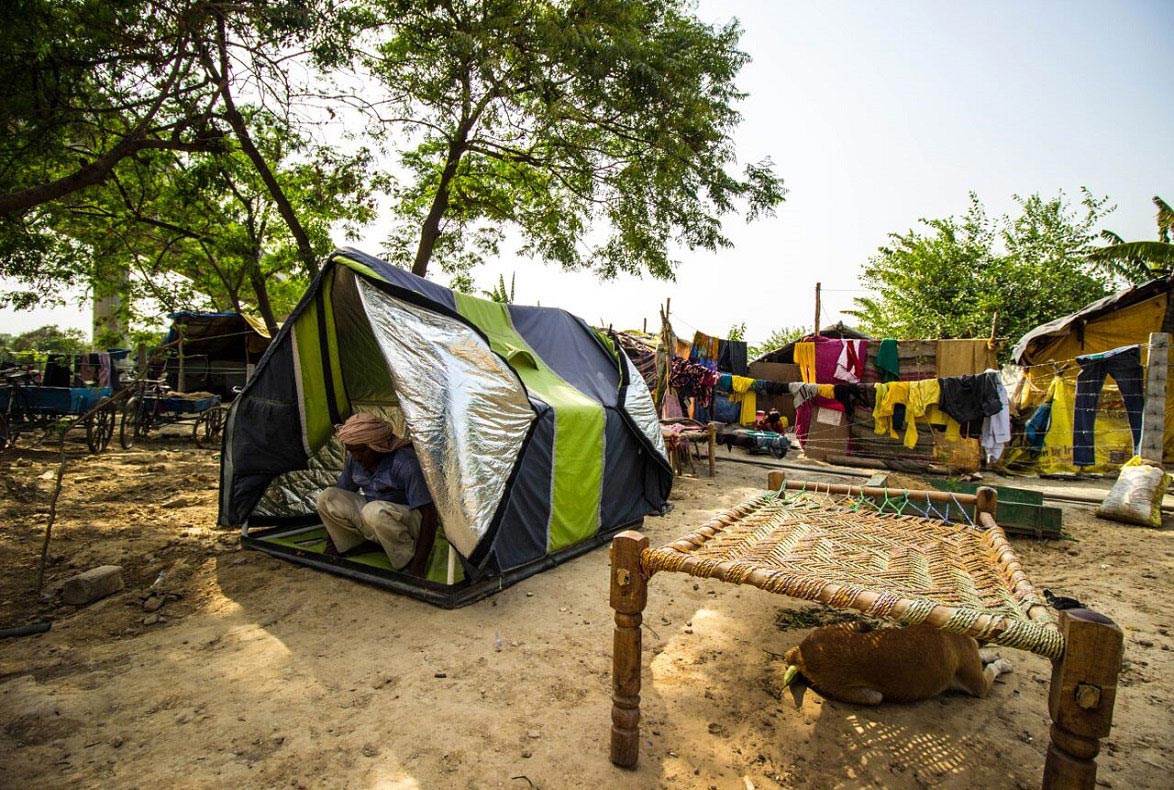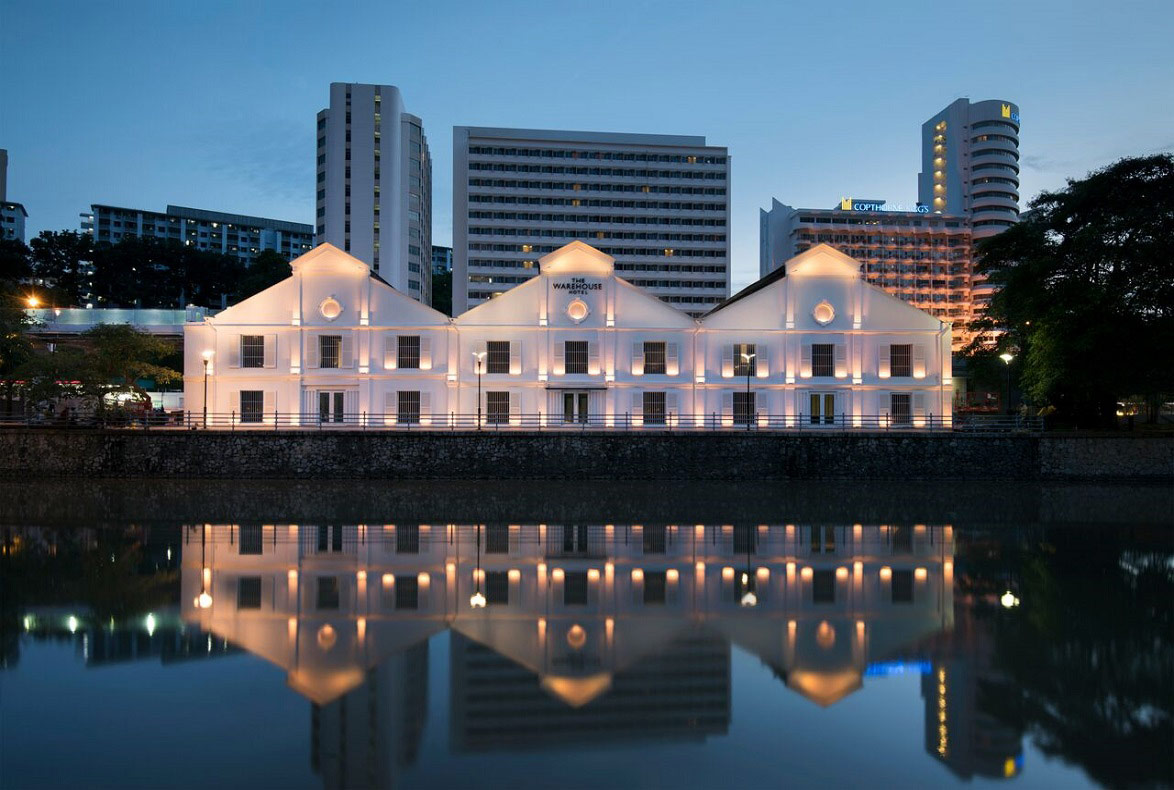* DESIGN OF
THE YEAR 2015
Prologue Collection
Outofstock designed Prologue Collection, a 12-piece set of teakwood furniture collection, with a very specific market in mind: Japan. When the designers accepted the commission from the client Scanteak – which was trying to expand their retail presence in Japan – they were well aware that cultural and social norms played an important role in informing and influencing consumers. Both Outofstock and Scanteak were especially aware of the importance of research to uncover user insights before design ideation.
The key research took place in densely populated Tokyo, Osaka and Kobe with a myriad of houses, condominiums and public housing flats. Predominantly, space was scarce but the designers were keen to tap into the collective knowledge of adaptive living in the context of shrinking floorplans to reframe their design brief.
The designers asked: “How do we design furniture that transcends decreasing spatial boundaries? What are the attitudes of the Japanese consumers towards furniture? And how do we influence their motivations to buy, use and maintain a chair or table?”
Through their research, Outofstock began to understand the cultural values and living rituals that drive the choices of Japanese consumers. Insightful observations were collected: A lady shared her childhood nostalgia through a wooden chair that her mother kept for her, aptly placed next to the wooden tricycle her son now uses. An elderly couple remembered a Danish dining table they had been using for 20 years, and portholes in the walls that allowed their cat to move freely between rooms.
Outofstock also trailed a Scanteak delivery truck for two days to get a glimpse into the homes behind closed doors. Outofstock spoke with the Scanteak’s Japanese showroom staff. Over time, everyone on the front end of retail observed the hidden needs and motivations behind a customer’s request. Bringing this intuitive knowledge to the drawing board was part of the design process.
The result of the research was the Prologue Collection: teak furniture with a lightweight visual language and versatility in function. Teak, a luxury wood, is pared down and softened with upholstery and textiles in hues of blue. Wide armrests hold a cup of tea; coffee tables are raised just that bit higher to function as a work surface; benches pivot to orientate flexibly for dual spaces.
The Outofstock team continues to learn from feedback it receives to make further tweaks and edits. In so doing, they are reminded of Ushio-san – their translator and experienced employee of Scanteak – who shared his distillation of what furniture means to the Japanese. “The agriculture legacy of their forefathers has given them the perspective of a landowner. For them, the home is like a piece of land; his furniture, the crops that he takes good care of as they age with him. Furniture should accompany a person on his journey through life. A table of 20 years speaks of countless stories of family activities, whilst a chair shines with the lustre of age and use.”
READ MOREABOUT THE DESIGNER
With offices in Singapore, Barcelona and Buenos Aires, and projects across the world, the design collective, Outofstock couldn’t be more global. Yet, when it comes to design, its founders Sebastián Alberdi, Wendy Chua, Gustavo Maggio and Gabriel Tan understand that a single solution does not fit all. Indeed, for the designers, accommodating the needs of people of different cultures and diversity of circumstances in which they live will always supercede any preconceived notions of what design is, or should be. This inclusive and respectful approach to design – and the belief that “it is not design that reflects one’s philosophy, but rather the way of living that imbues design with life’s philosophies” – has seen Outofstock’s rapid rise since it was established in 2006 to become an international design collective of considerable repute with clients such as Ligne Roset, Bolia, Environment, Industry+ and Scanteak. Outofstock’s commission to design the centennial exhibition of Sori Yanagi in Singapore left visitors with an indelible mark. Yanagi, after all, championed “anonymous design” and devoted his life to designing utilitarian products and furniture for quotidian living. “That a designer can achieve such success and be humble and self-deprecating – despite the deep influence of his work on other designers – is nothing short of rare lucidity,” the designers say. Interestingly, all four partners of Outofstock are adjunct faculty or visiting lecturers of design schools in Singapore, Spain, Mexico and the United States. And it is through teaching that they have concluded that “design is not a talent, but a sensibility”. These sensibilities, they add, cannot be pushed or incentivised because this would lead to quick, but short-term, success. Instead, Outofstock believes that a design sensibility must be nurtured. “Nurturing sensibilities is a generational process through education. Children are born with curiosity and a sense of wonder. With a little guidance, their creativity will naturally blossom. As an adult, one needs to ‘unlearn’ in order to learn and so it is more difficult – but not impossible – to transform otherwise closed mindsets.
This playful thrust is a thread in the designer’s work. Everyday objects – many rooted in Southeast Asian design – are reimagined with restless imagination and cheerful glee.
“My work is often occupied with the authenticity of the contemporary design artefact being a deliberate gesticulation of material culture,” says Hans, who is also an assistant professor at the National University of Singapore’s Division of Industrial Design.
And so, a tray is made of white nylon springs made from 3D imaging. The patterns on a traditional Peranakan teapot are perforated into individual dots that resemble a magnified Roy Lichtenstein print. A sequence of Singapore’s national lion symbol transforms an ordinary white plastic shopping bag into an eye-catching accessory. Each work provides a fresh perspective and brings a smile to one’s face.
This is not to imply that Hans’s work is without discipline. For all the apparent frivolity of the final product, he takes the task of design seriously, investing his work with impressive fundamentals. Every design is never produced for its own sake. Every finished product can actually be used. As Hans points out: “I see design as a medium, and I make use of its utility as a pretext to explore ideas.”
When asked what, or who, has influenced his design philosophy, his reply is as instructive for neophyte designers as it is remarkably nuanced: “The perceptiveness of Gaston Bachelard’s work on phenomenology; the lightness in Italo Calvino’s conceptual yet narrative approach to writing; and Georges Perec’s sheer wit in describing everyday life.”
In Han’s case, everyday life means the local Singaporean culture. “That’s always been a major influence on my work. I cannot imagine responding to the condition of being Singaporean without being in Singapore.”
This perspective has been hard-earned. His greatest mistakes have occurred when the value or potential of a design, or the complexity of the process is not recognised from the outset. This is a theme that runs through in his work and in his lectures. “The underlying principle of many of the pedagogical methods and strategies I develop are rooted in the idea that creating is ‘deforming the existing’, rather than ‘creating anew’.”
Given this sense of connection between time and place, it’s no surprise that Hans sets the value of the President’s Design Award so firmly within a local context. He is especially appreciative that “it has created a benchmark for design in Singapore, and places a seal of worth on design at a national level”.
READ MOREDESIGNER
Outofstock Pte Ltd
Gabriel Tan
Gustavo Maggio
Sebastian Alberdi
Wendy Chua
Insights from the Recipient
Citation
Jury Citation
Outofstock was commissioned by Singaporean manufacturer Scanteak to create a furniture range for the Japanese market. Before committing anything to paper, the principal designers decided to embark on an intensive research trip to Japan to study the country’s typologies, living spaces and cultural habits. Their home visits and interviews resulted in a human-centric furniture collection that is full of subtle, sensitive and insightful details. The flippable back-rest of the Duo Swivel Bench allows users to sit facing either the dining table or the living room simply by changing the direction of the back-rest. Equally ingenious is the angled shelf under the coffee table that provides storage without impeding leg-room when the user is using the coffee-table as an impromptu work surface.
VIEW JURORSNominator Citation
FOO AH HIONG
EXECUTIVE DIRECTOR
SCANTEAK (HAWAII FURNISHING PTD LTD)
The Prologue Collection features teak furniture pieces in smaller proportions and cleaner forms. It was largely inspired by the Japanese lifestyle, which is predisposed towards design based on the natural texture of wood. In particular, the collection is the culmination of intensive research – through home visits and observations conducted by Outofstock in Japan – into contemporary living rituals in increasingly dense cities.
Compromising neither form nor function, the Prologue Collection comprises elegantly unassuming designs that are, nevertheless, functional works of art in the way they dovetail teak home furnishings with users’ needs. The Duo Swivel Bench, for example, has a back-rest that moves to face two directions without the need to turn the entire seat around. This flexibility is achieved by a structural innovation that creates a thin, long back-rest that will not warp, nor sacrifice strength and durability. It is a clever detail that is eminently suitable for small spaces. Sharing a similar design philosophy to furniture created in Scandinavia and Japan, Prologue is simple and minimalistic while accentuating a quiet elegance.


